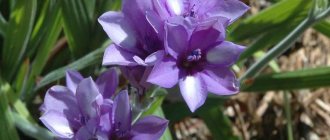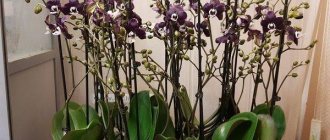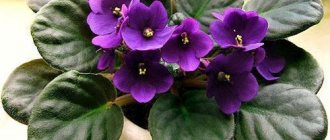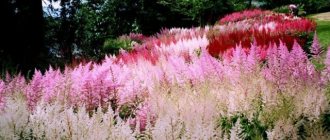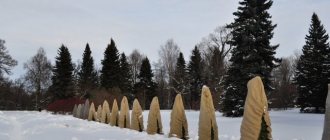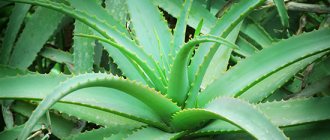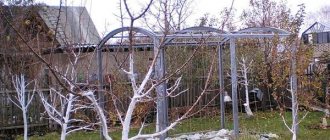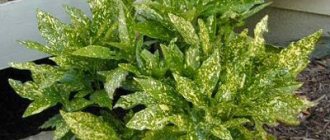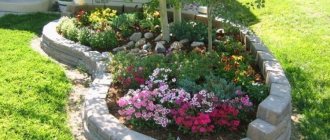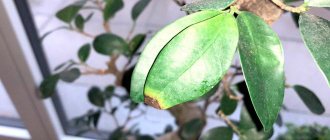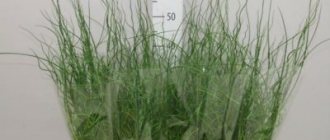Botanists name 700 varieties of ferns from the Kostenzovy family. The plant is beautiful, unpretentious in care, indoor and garden varieties are cultivated (in suitable climatic conditions).
The homeland of asplenium is Australia, Malaysia and Southeast Asia. If favorable conditions are created for the plant, it will grow into a voluminous bush with long leaves.
Description
The Asplenia family includes about 500 species of ferns; they are perennial plants with a creeping rhizome covered in soft scales. The leaves are smooth, regular and pinnately dissected. The sporangium (the organ that produces spores necessary for reproduction) is located in the lower part of the leaves, on the free veins.
There are non-winter-hardy, winter-hardy and deciduous varieties. Tropical species are grown indoors, they are beautiful and do not require careful care.
South Asian Asplenium (A. Australasicum)
When looking at a photo of South Asian asplenium, the plant can be confused with other species that have solid long leaves.
The fern, native to the east coast of Australia and Polynesia, can live both on the ground, under the canopy of tropical forests, and in plant trunks. At the same time, the type of asplenium shown in the photo is a very large plant with one and a half meter long oblanceolate leaves. The rosette has the appearance of a dense, high rosette in the shape of a funnel or bowl.
Spore maturation takes place on the inside of the leaf blade. The sori are linear, convex, located on the upper part of the leaf near the dark central vein.
Kinds
In our country, only a few varieties of plants grow in open ground.
| View | Description |
| Asplenium black | It belongs to the medicinal varieties; in Russia it grows without shelter only in the southern part. |
| Viviparous or bulbous fern | It has very beautiful dark green leaves with a pinnate dissection. There are bulbs at the ends of the bulbiferum. Viviparous fern grows well in moist soil; young cuttings must be regularly transplanted from the mother stem, otherwise she will kill them. Height up to a meter. Another name is Parvati. |
| South Asian Asplenium | A very beautiful type of asplenium with dense green leaves. Their edges are wavy, up to 25 cm long. There is a purple vein running down the center of the leaf. |
| Nesting asplenium or Nidus | The leaves of the “bird's nest” are bright and shiny, up to 45 cm long with a light green color, sword-shaped in shape, and the edges are wavy. The rosette is shaped like a ladle. Another name is “Cobra”. |
| Scolopendra Asplenium | Indoor type of fern, leaves are light green, curly edges. Young plants grow with vertical leaves, after which they take the shape of an arc. People call it “centipede”; the leaves should not be touched unless necessary, as they are extremely sensitive. |
| Osaka, antikum | The rarest plant of the Asplenia species, it is also called tree-like. The leaves grow vertically upward, bright, shiny, light green. |
| Bottle Asplenum | Quite demanding to care for, can be grown in an aquarium. The leaves are dark green, triangular in shape, growing up to 14 cm high. |
| Krispy | Does not require careful care, the leaves have a corrugated structure, a bright green hue and an incredible shine. Another name is Krispy wave. |
| Leslie | A miniature type of fern, popular among gardeners. |
| Hairy Asplenium | A small stone, up to 25 cm long. The leaves are pinnate, long, light green in color and are on dark brown petioles. Prefers to grow on rocks, in places where there is little soil. This species can be grown not only at home, but also in the garden. |
Asplenium scolopendra (A. scolopendrium)
It’s hard to imagine, but the Asplenium scolopendra shown in the photo is an inhabitant of European forests. From Germany to Britain you can see wild specimens of this fern with whole leathery leaves up to 40 cm long.
In contrast to the nest-like asplenium, the scolopendra osseptum forms a less powerful and dense rosette. In this case, the dark petioles are somewhat longer, and the almost erect young leaves begin to bend as they grow.
If the main form of the plant has slightly wavy leaf edges, then in the subspecies crispum and undulatum one can observe foliage with beautiful corrugated edges. Such plants are highly valued by gardeners. Breeders have already presented lovers of decorative deciduous crops with several varieties and hybrids of the spectacular Asplenium scolopendra, as in the photo.
Fern care
The fern does not require careful care at home.
| Parameter | Conditions |
| Lighting/Location | The most important thing is not to place the flower in direct sunlight. Otherwise he will get burned. The light should diffuse softly into the room. Shadow slows down flower growth. It is advisable to place the pot with fern on the east side. |
| Temperature | In winter the temperature should be +19 degrees, in summer from +21 to +25 degrees. |
| Watering | Water the fern as needed; do not allow the soil to dry out. In summer it needs more frequent watering, and in winter, vice versa. The water should be soft. If the soil is too wet, the root system will rot. |
| Air humidity | It is advisable to maintain high air humidity in the apartment; you can additionally place a vessel with water next to the pot. |
| Fertilizer | Additional fertilizing is necessary in the summer once every 2 weeks; special mineral fertilizers are sold. In the fall, fertilizing should be stopped. Before adding fertilizer, it is advisable to water the plant thoroughly. |
What are the requirements for growing indoors?
Provide the asplenium with sufficient space to develop. Its main advantage is its beautiful leaves. But they are quite fragile. If you place a fern in close flower company, the beauty of the plant will fade.
Asplenium is not very demanding to care for. At home, it grows actively, increasing the green mass of young leaves. Take care of high air humidity, avoid drying out and overheating, shade the plant on a hot afternoon, and enjoy tropical greenery without leaving home.
Table: seasonal conditions
| Season | Temperature | Humidity | Lighting |
| Spring | Asplenium is a heat-loving fern. A constant temperature in the range of 20–25°C is ideal. He can hardly bear the heat. It is necessary to ventilate the room with the plant, but protect it from drafts and cold winds. | Humidity is high - 60%. Leaves need to be sprayed daily. On particularly hot days, take care to additionally increase the humidity around the plant. Avoid getting moisture into the center of the leaf rosette. | Diffuse light or partial shade. Possibly some sun in the morning and evening. An east or north window is the best place. You can also place it near the western one, but behind a curtain. If the asplenium is on the south side, the distance to the window should be at least 3 m. |
| Summer | |||
| Autumn | The average temperature is 18°C. Do not allow the temperature to drop to 10°C or lower. Keep away from batteries. | The frequency of spraying is reduced. Use only warm and settled water. | |
| Winter |
As you already understand, asplenium needs a special microclimate . But if there are no particular difficulties with lighting, then maintaining a high level of humidity will require some effort. Heating can make the air as dry as the Sahara by mid-winter. And the fern is a tropical plant, the desert will kill it. How can you recreate a tropically humid climate for asplenium in an ordinary apartment?
- Place the asplenium in a room where the air is most humid. For example, in the kitchen or in the bathroom, if there is a window there.
- Spray the plant from all sides with a spray bottle. Use only warm water. In winter, carry out the procedure in the first half of the day so that the leaves dry before evening. In summer, avoid spraying at midday to avoid burns.
- Place aspleniums next to the same moisture-loving plants. Then, after water treatments, the moisture will remain longer.
- Place an aquarium or home fountain nearby.
- Place the pot with the plant on a tray with pebbles or expanded clay. Keep them moisturized constantly.
- Give asplenium a double pot. Place the container in which the fern grows in a waterproof container filled with sphagnum moss or peat. Keep the substrate moist at all times. Excess moisture evaporating from the second pot will maintain air humidity.
What you should pay attention to when choosing asplenium (ossene)
When purchasing asplenium, carefully examine the plant to see if there are pests or signs of any diseases . For example, brown shells unevenly distributed across the leaves are a scale infestation. This plant is not worth buying.
Asplenium leaf with spores
But brown dots or stripes on the underside of the sheet are not a problem. The plant has produced spores and these can be collected to propagate Asplenium.
When choosing a plant, give preference to specimens with bright, fresh leaves . They should not have dry ends or yellowish spots. This is usually the result of exposure to dry air or improper watering.
When you bring the plant home, quarantine it for about a month, away from other plants. During this time, pests that escaped your attention in the store may manifest themselves. In addition, your asplenium adapts to the new room. Care for it as recommended, but do not feed it so as not to stimulate growth during the adaptation period.
Flowers are kept in a special soil for transportation; it is poor in nutrients. After quarantine, the asplenium must be transplanted into a suitable substrate.
Selection of container, soil, transplantation
As soon as the quarantine time has passed, the asplenium must immediately be transplanted into a separate container. You should leave the clod of earth with the roots, only lightly shaking off the excess soil.
Young plants will have to be replanted every year, preferably in the spring. Adults - rejuvenate every 2 years. The pot for planting should be larger than the previous one, but not huge, as the plant will not like it. The container must be selected with holes.
Suitable soil for planting orchids. This mixture is easy to prepare yourself. Soil composition: peat, sand, pine bark, humus and charcoal.
Step-by-step transplant:
- Choose a pot with holes for air and add drainage to the bottom.
- Place the substrate on top; it should remain loose.
- Remove the stone from the pot with a lump of earth on the roots and place it in another container. Before doing this, remove the black roots.
- Pour a portion of the substrate on top and lightly compact it at the roots.
- Then pour in slightly warm water and spray with a spray bottle.
- Place the pot in a dark place for a while.
Reproduction
Asplenium is a plant species that never blooms. Ferns reproduce by three main methods:
- Reproduction by brood buds occurs in viviparous ferns. The buds are located at the tips of the leaves, grow on the flower for a short time and then acquire their own leaves and roots.
- By dividing the rhizomes, you can propagate a large, mature bush.
- It is very difficult to propagate ospores by spores. You will need special equipment and a lot of time. Shoots appear at temperatures from +20 to +25 degrees.
How does asplenium reproduce?
Asplenium reproduces in 3 ways: by brood buds, spores and rhizome division.
Brood buds
In Asplenium bulbiferous and viviparous, brood buds appear at the tips of the leaves. They grow for some time, acquire leaves and roots, and then fall off. Such daughter plants can be broken off along with a piece of frond.
- Plant the onion in a small container with a nutritious and loose substrate.
- Build a greenhouse using a glass jar or transparent bag.
- Keep the young plants “under a hood” until they take root.
- Ventilate and moisten the greenhouse daily.
- After rooting, remove the protection. Transplant the young plant into a large container.
Asplenium leaf with brood buds
Rhizome division
A large bush is propagated in this way, combining the process with spring replanting. Each division must have a sufficient number of growth points.
- Remove the asplenium bush from the pot.
- Clean the root system from the substrate.
- Using a sharpened knife, cut the rhizome into pieces.
- Plant each one in a separate container with loose soil.
- Moisten the plantings, spray the leaves and soil.
- Be sure to carry out foliar feeding.
- The seedlings will develop slowly for about a month. Once they are established, care for them as you would for mature plants.
It is necessary to divide the asplenium rhizome during transplantation
Controversy
It is quite difficult to propagate asplenium by spores. This will require special equipment and a lot of time. Seedlings germinate at a temperature of 22–25°C, so you will need a heated nursery. Do you have one and are not afraid of difficulties? Then let's get to work.
- We select a large leaf with ready-made sporangia, these are brown tubercles at the bottom of the leaf where spores are stored.
- Cut the leaf and scrape the spores onto a piece of paper.
- We sterilize the soil for planting - heat it in a frying pan or in the oven.
- We pour drainage and light substrate into the nursery. We water it generously.
- Spread the spores evenly over the surface and cover the container with glass.
- We place the nursery in a dark and warm room.
- We ventilate and moisten the crops every day. It will take several months for the spores to germinate.
- After this, we remove the glass and move the nursery to a lighted place.
- We thin out the seedlings, leaving the strongest ones. The distance between them should be 3 cm.
- After a month, plant several young asplenium plants in small pots.
Asplenium leaf with spores
Video: fern propagation at home
https://youtube.com/watch?v=VK5B8l7bttc
Some amateur gardeners prefer to grow flowering plants. No doubt about it, they are wonderful. You won't get flowers from asplenium. If your fern suddenly blooms, it will be a miracle, shoot a video, take photos and tell the whole world about the sensation! But asplenium itself is a miracle. This amazing plant can be placed away from a window to create a green tropical island in a shaded corner of your home, hung in a planter, or used to decorate cabinets in the kitchen or living room. Exotic carved asplenium greenery would be appropriate everywhere!
Errors and their correction
Ferns are susceptible to various diseases.
| Error | Cause | Correction |
| The leaves are yellow, the tips are brown. | Dry air. | Place an additional vessel of water near the container with the plant. |
| Brown spots appear on the leaves, they turn yellow and die. | – too much overheating; – insufficient watering; – wind and drafts. | Water the flower well and remove it from the heater. |
| The leaves are dying. | Too dry air, dry soil. | Follow all rules for caring for asplenium. |
| Burns on the leaves, they turn pale. | Bright sunlight. | Place away from the window in a dark place. |
| Poor growth, pale leaves. | Few nutrients. | Feed well with fertilizers. |
Possible growing problems
Insect pests may include spider mites and scale insects. It should be dealt with using traditional methods.
Many problems can be caused by errors in care.
- Brown spots or stripes appear at the bottom of the leaf blade. This moment confuses many beginners; in fact, this is how the formation of spores begins during the period of sporulation. If this does not happen, there is no need to worry either; spores ripen only on sufficiently mature specimens.
- The tips of the leaves begin to dry - a sign of excess moisture or, conversely, drying out of the substrate.
- If they curl, but do not dry, then the problem may be too low a temperature or a constant draft, which asplenium does not like.
- Fading leaves or traces of burns - excessive lighting, an excess of bright light. In this case, you need to move the plant to another place gradually, not immediately from a bright place to a dark one, so as not to aggravate the problem with stress and too short an adaptation period.
- Limp leaves - the cause is excess moisture in the soil, constant overwatering, as a result of which, most likely, putrefactive processes in the root system have already begun. Watering should be stopped and the plant observed. If there is no improvement or the problem progresses, an urgent transplant with a thorough revision of the roots is required.
Pests and their control
Kostenza greens are to the taste of pests. It is affected by aphids, mealybugs, whiteflies, and mites. Washing the leaves with soapy water helps a lot.
| Pest | Recognition | Treatment |
| Spider mite | White cobwebs and reddish spots form on the leaves. | Spraying with insecticides. |
| Mealybugs | The leaves are covered with white sticky fluff. | Use a damp cloth to remove pests and spray the leaves with alcohol. |
| Aphid | The leaves curl into a tube and turn pale. | Treat with a special product (Tanrek, Iskra, Aktara). |
| Whitefly | The leaves turn yellow and die. | Treat the leaves every three days with a solution containing permethrin. |
| Shchitovka | Hard spots of dark brown color. | Pests should be removed with a wet cloth and the flower should be sprayed with a special product (Bankol, Bitoxibacillin). Repeat manipulations until the insects disappear completely. |
Mr. Summer Resident informs: fern is a home talisman
Fern has long been considered a magical and magical plant. They believed that with its help you can find gold, and the asplenium seed brings good luck.
There are a huge number of signs associated with ferns:
- It is believed that the plant has a beneficial effect on the home environment, clears the air of negative thoughts, and returns harmony to the apartment. A flower makes people kinder and more open to communication.
- Asplenium improves relations between the older and younger generations. Promotes understanding between parents and children.
- Drives away evil spirits. A fern is considered a strong amulet; if it withers, it means that the house has been brought under the evil eye or damage.
- Attracts money into the house.
- One of the bad signs is that the flower is an energy vampire. To neutralize the negative impact, you need to place it near the TV or computer.
- Causes illness. This theory can be justified logically, because the owners may have a banal allergy to the plant. In addition, the fern absorbs a lot of oxygen, especially at night; in the morning, household members may have a headache. Therefore, plants should not be placed in the bedroom.
